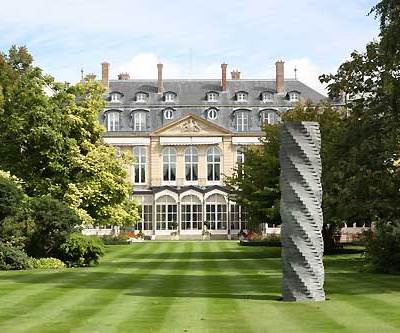The entrance hall to the Sainsbury Exhibitions Gallery at the British Museum is blood-red, and covered in Andy Warhol’s psychedelic screenprints of Marilyn Monroe’s face.
It’s a punchy start to the exhibition, ‘The American Dream: Pop to the Present’. It’s also a surprising one, considering what has appeared in the gallery since its opening in 2014 – Viking monuments, ancient Celtic crafts, and Ming dynasty vases. Although London is now achingly familiar with Pop art exhibitions (think of Tate Modern’s ‘The World Goes Pop’ last year, or ‘Pop Art Design’ at the Barbican the year before) the Pop art aspect of the show is swiftly, and refreshingly, brushed over. Instead, a broader reflection on printmaking since the 1960s is presented – made possible by generous supporters in the museum’s Vollard Group.
Made in California (1971), Ed Ruscha. © Ed Ruscha. Reproduced by permission of the artist.

It also couldn’t have happened without curator Stephen Coppel, who has dedicated much of his career to putting printmaking more prominently on the map. For this ambitious exhibition, Coppel wanted to create a potted history of modern American politics, as seen through the country’s artwork. It feels timely in the context of America’s current unusual political climate, and will no doubt get bodies through the door.
Thankfully, the audaciously red walls in the entrance lobby subside as the exhibition continues; as the wall colour weakens, so does the idea of the American Dream, which grows increasingly contorted, twisted and ironic. Coppel has collected an astounding array of prints that support this development – 200 to be precise. ‘I encourage everyone to go and see this exhibition,’ he tells me, ‘simply because I really don’t think this range and number of artworks on the subject will be seen again together for a long, long time.’
Gumball Machine (1970), Wayne Thiebaud. © Wayne Thiebaud/DACS, London/VAGA, New York 2016

He’s right. Generally speaking, the bigger the blockbuster, the more predictable the viewing. But Coppel and his curators have used some clever design techniques to trick viewers into believing they are seen something akin to an ‘indie’ production. In doing so, they’ve dodged the bullet of predictability, and created something subversive and tongue-in-cheek.
The huge gallery has been sub-divided into 12 different ‘rooms’, each assigned a theme, and laid out chronologically. Though this might not seem like a particularly groundbreaking design concept, it’s a sensible decision given the vast time period that the exhibition covers. Coppel has prevented the timeline design from becoming plodding or stagnant by adding holes (or ‘cut-outs’) in the walls. ‘Visitors can peak through to different rooms. It’s like seeing into the future,’ he explains.
Standard Station (1966), Ed Ruscha. The Museum of Modern Art, New York/Scala, Florence. © Ed Ruscha. Reproduced by permission of the artist.

And the future doesn’t look pretty. The sense of impending doom builds as we hike along the timeline, which is made more brutal by the exhibition’s early moments of rose-tinted cheeriness. The room ‘Made in California: the West Coast Experience’ houses an array of zesty and optimistic Ed Ruscha prints, such as his 1966 Standing Station, which capture his wry, laid-back vision of 1950s Americana. We see the American Dream in practice through the inclusion of work from German émigrés Josef and Anni Albers, who fled Germany for the US in 1933. The pair’s successful careers in American academia are surely proof that the ‘dream’ did work for some. Josef Albers’ sunshine yellow Homage to the Square (1973) seems to glow with this sense of hope and achievement.
A room concentrating on conceptual and minimal works from the 1970s offers a monochrome break from the kalaiedoscopic colour elsewhere. Here, Donald Judd’s moody swathes of black paint on white canvas, seen in works such as Untitled (1980), seem anxiety-ridden, foreshadowing the darker turn the exhibition is about to take.
no world from An Unpeopled Land in Uncharted Waters (2010), Kara Walker. © Kara Walker. Reproduced by permission of the artist

The second half of the exhibition is shorter, angrier, and arguably more powerful. We journey through the art of economic downturn, the Aids epidemic, 9/11, and issues of race and sexuality. Jenny Holzer’s quietly brilliant Inflammatory Essays from 1982 consists of visceral lines of frustrated poetry. One reads, ‘HER KILLS NOURISH STRONG LIFE. SQUEAMISHNESS IS THE CRIME,’ portraying how the printing press was used during that time as a means of political communication. ‘The artist did not initially intend these works to be seen in a gallery,’ Coppel tells me. ‘She anonymously pasted them to walls of public buildings across New York.’ Indeed, the tone of the exhibition shifts towards one that emphasises the propagandist capabilities of printmaking, reflecting how the printing press had changed from a tool used to capture frivolous celebrity – as it did in Pop art’s early days – to being a means for political change.
Holzer’s guerilla-art tactics lead neatly into those of the Guerrilla Girls. Here, one of their early posters cites ‘not having the pressures of success’ as an ‘advantage of being a woman artist.’ Such comments on art world gender inequality force us to consider just how few female artists the first half of the exhibition features. That the second half sees a much broader representation is one substantial cause for cheer, offering hope in an otherwise materially challenging viewing experience, where current political uncertainty bubbles under the surface.
Vote McGovern (1972), Andy Warhol. © 2016 The Andy Warhol Foundation for the Visual Arts, Inc./Artists Rights Society (ARS), New York and DACS, London

Trump’s presidency was a mere twinkle in his eye when Coppel began devising this exhibition five years ago. That an exhibition on contemporary American politics opens just as pages are hacked from the political rulebook seems brilliantly coincidental. Though Coppel does not comment on the new President directly, the exhibition concludes with Ed Ruscha’s artfully rusted old signs – which look like dour, colourless reflections of his earlier peppy work. The final sign we see has the words ‘DEAD END’ punched into it – which speaks volumes.
‘The American Dream: Pop to the Present’ is at the British Museum, London until 18 June.



